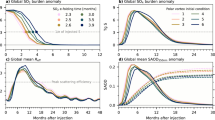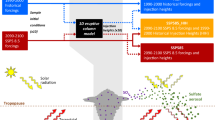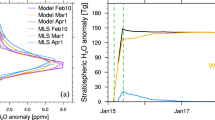Abstract
The climate impact of a volcanic eruption is known to be dependent on the size, location and timing of the eruption. However, the chemistry and composition of the volcanic plume also control its impact on climate. It is not just sulfur dioxide gas, but also the coincident emissions of water, halogens and ash that influence the radiative and climate forcing of an eruption. Improvements in the capability of models to capture aerosol microphysics, and the inclusion of chemistry and aerosol microphysics modules in Earth system models, allow us to evaluate the interaction of composition and chemistry within volcanic plumes in a new way. These modelling efforts also illustrate the role of water vapour in controlling the chemical evolution — and hence climate impacts — of the plume. A growing realization of the importance of the chemical composition of volcanic plumes is leading to a more sophisticated and realistic representation of volcanic forcing in climate simulations, which in turn aids in reconciling simulations and proxy reconstructions of the climate impacts of past volcanic eruptions. More sophisticated simulations are expected to help, eventually, with predictions of the impact on the Earth system of any future large volcanic eruptions.
This is a preview of subscription content, access via your institution
Access options
Subscribe to this journal
Receive 12 print issues and online access
$259.00 per year
only $21.58 per issue
Buy this article
- Purchase on Springer Link
- Instant access to full article PDF
Prices may be subject to local taxes which are calculated during checkout


Similar content being viewed by others
References
Franklin, B. Meteorological imaginations and conjectures. Mem. Lit. Phil. Soc. Manchester 2, 357–361 (1785).
Humphreys, W. J. Physics of the Air (McGraw-Hill, 1940).
Budyko, M. I. The effect of solar radiation variations on the climate of the Earth. Tellus 21, 611–619 (1969).
Pollack, J. B. et al. Volcanic explosions and climatic change: a theoretical assessment. J. Geophys. Res. 81, 1071–1083 (1976).
Rampino, M. R. & Self, S. Sulphur-rich volcanic eruptions and stratospheric aerosols. Nature 310, 677–679 (1984).
Stenchikov, G. L. et al. Radiative forcing from the 1991 Mount Pinatubo volcanic eruption. J. Geophys. Res. 103, 13837 (1998).
Krueger, A. J. et al. Volcanic sulfur dioxide measurements from the total ozone mapping spectrometer instruments. J. Geophys. Res. 100, 14057–14076 (1995).
Sato, M., Hansen, J. E., McCormick, M. P. & Pollack, J. B. Stratospheric aerosol optical depths, 1850–1990. J. Geophys. Res. 98, 22987–22994 (1993).
Carn, S. A., Clarisse, L. & Prata, A. J. Multi-decadal satellite measurements of global volcanic degassing. J. Volcanol. Geotherm. Res. 311, 99–134 (2016).
Hansen, J. et al. In The Mount Pinatubo Eruption: Effects on the Atmosphere and Climate NATO ASI Series, Vol. I 42 (eds Fiocco, G., Fua, D. & Visconti, G.) 233–272 (Springer, 1996).
Winter, A. et al. Persistent drying in the tropics linked to natural forcing. Nature Commun. 6, 7627 (2015).
Shindell, D. T., Schmidt, G. A., Mann, M. E. & Faluvegi, G. Dynamic winter climate response to large tropical volcanic eruptions since 1600. J. Geophys. Res. 109, D05104 (2004).
Robock, A. Volcanic eruptions and climate. Rev. Geophys. 38, 191–219 (2000).
Wahl, E., Diaz, H. F., Smerdon, J. & Ammann, C. Late winter temperature response to large tropical volcanic eruptions in temperate western North America: relationship to ENSO phases. Glob. Planet. Change 122, 238–250 (2014).
Pausata, F. S. R., Chafik, L., Caballero, R. & Battisti, D. S. Impacts of high-latitude volcanic eruptions on ENSO and AMOC. Proc. Natl Acad. Sci. USA, http://dx.doi.org/10.1073/pnas.1509153112 (2015).
Coffey, M. T. Observations of the impact of volcanic activity on stratospheric chemistry. J. Geophys. Res. 101, 6767–6780 (1996).
Turco, R. P., Whitten, R. C. & Toon, O. B. Stratospheric aerosols: observation and theory. Rev. Geophys. Space Phys. 20, 233–279 (1982).
Rampino, M. R. & Self, S. Volcanic winter and accelerated glaciation following the Toba super-eruption. Nature 359, 50–52 (1992).
Bekki, S. Oxidation of volcanic SO2: a sink for stratospheric OH and H2O. Geophys. Res. Lett. 22, 913–916 (1995).
Oppenheimer, C. Limited global change due to the largest known Quaternary eruption, Toba ∼74 kyr BP? Quat. Sci. Rev. 21, 1593–1609 (2002).
Schmidt, A. et al. Selective environmental stress from sulphur emitted by continental flood basalt eruptions. Nature Geosci. 9, 77–82 (2015).
Robock, A. et al. Did the Toba volcanic eruption of ∼74 ka B.P. produce widespread glaciation? J. Geophys. Res. 114, http://dx.doi.org/10.1029/2008jd011652 (2009).
Stenke, A. & Grewe, V. Simulation of stratospheric water vapor trends: impact on stratospheric ozone chemistry. Atmos. Chem. Phys. 5, 1257–1272 (2005).
Glaze, L. S., Baloga, S. M. & Wilson, L. Transport of atmospheric water vapor by volcanic eruption columns. J. Geophys. Res. 102, 6099 (1997).
Joshi, M. M. & Jones, G. S. The climatic effects of the direct injection of water vapour into the stratosphere by large volcanic eruptions. Atmos. Chem. Phys. 9, 6109–6118 (2009).
Schmidt, G. A. et al. Climate forcing reconstructions for use in PMIP simulations of the last millennium (v1.0). Geosci. Model Dev. 4, 33–45 (2011).
McGregor, H. V. et al. Robust global ocean cooling trend for the pre-industrial Common Era. Nature Geosci. 8, 671–677 (2015).
Timmreck, C. et al. Limited temperature response to the very large AD 1258 volcanic eruption. Geophys. Res. Lett. 36, http://dx.doi.org/10.1029/2009GL040083 (2009).
Toohey, M., Krüger, K., Niemeier, U. & Timmreck, C. The influence of eruption season on the global aerosol evolution and radiative impact of tropical volcanic eruptions. Atmos. Chem. Phys. 11, 12351–12367 (2011).
Mann, M. E., Fuentes, J. D. & Rutherford, S. Underestimation of volcanic cooling in tree-ring-based reconstructions of hemispheric temperatures. Nature Geosci. 5, 202–205 (2012).
Frank, D. C. et al. Ensemble reconstruction constraints on the global carbon cycle sensitivity to climate. Nature 463, 527–530 (2010).
LeGrande, A. N. & Anchukaitis, K. J. Volcanic eruptions and climate. PAGES 23 46–47 (2015).
Sigl, M. et al. Timing and climate forcing of volcanic eruptions for the past 2,500 years. Nature 523, 543–549 (2015).
Esper, J., Büntgen, U., Luterbacher, J. & Krusic, P. J. Testing the hypothesis of post-volcanic missing rings in temperature sensitive dendrochronological data. Dendrochronologia 31, 216–222 (2013).
Bauer, S. E. et al. MATRIX (Multiconfiguration Aerosol TRacker of mIXing state): an aerosol microphysical module for global atmospheric models. Atmos. Chem. Phys. 8, 6003–6035 (2008).
Schmidt, G. A. et al. Configuration and assessment of the GISS ModelE2 contributions to the CMIP5 archive. J. Adv. Model. Earth Syst. 6, 141–184 (2014).
Sander, S. P. et al. Chemical Kinetics and Photochemical Data for Use in Atmospheric Studies Report No. 17 (NASA Jet Propulsion Laboratory, 2011).
Vehkamäki, H. An improved parameterization for sulfuric acid–water nucleation rates for tropospheric and stratospheric conditions. J. Geophys. Res. 107, http://dx.doi.org/10.1029/2002jd002184 (2002).
Mann, G. W. et al. Intercomparison and evaluation of global aerosol microphysical properties among AeroCom models of a range of complexity. Atmos. Chem. Phys. 14, 4679–4713 (2014).
Textor, C. et al. Analysis and quantification of the diversities of aerosol life cycles within AeroCom. Atmos. Chem. Phys. 6, 1777–1813 (2006).
Seinfield, J. H. & Pandis, S. N. Atmospheric Chemistry and Physics: From Air Pollution to Climate Change 2nd edn (Wiley, 2006).
Chapman, S. A Theory of Upper-atmospheric Ozone (Edward Stanford, 1930).
Solomon, S. et al. The role of aerosol variations in anthropogenic ozone depletion at northern midlatitudes. J. Geophys. Res. 101, 6713–6727 (1996).
Tie, X. & Brasseur, G. The response of stratospheric ozone to volcanic eruptions: Sensitivity to atmospheric chlorine loading. Geophys. Res. Lett. 22, 3035–3038 (1995).
Rozanov, E. V. Climate/chemistry effects of the Pinatubo volcanic eruption simulated by the UIUC stratosphere/troposphere GCM with interactive photochemistry. J. Geophys. Res. 107, http://dx.doi.org/10.1029/2001jd000974 (2002).
Aquila, V., Oman, L. D., Stolarski, R., Douglass, A. R. & Newman, P. A. The response of ozone and nitrogen dioxide to the eruption of Mt. Pinatubo at southern and northern midlatitudes. J. Atmos. Sci. 70, 894–900 (2013).
Read, W. G., Froidevaux, L. & Waters, J. W. Microwave limb sounder measurement of stratospheric SO2 from the Mt. Pinatubo volcano. Geophys. Res. Lett. 20, 1299–1302 (1993).
Nedoluha, G. E. et al. Increases in middle atmospheric water vapor as observed by the Halogen Occultation Experiment and the ground-based Water Vapor Millimeter-Wave Spectrometer from 1991 to 1997. J. Geophys. Res. 103, 3531–3543 (1998).
Vernier, J. P. et al. Major influence of tropical volcanic eruptions on the stratospheric aerosol layer during the last decade. Geophys. Res. Lett. 38, http://dx.doi.org/10.1029/2011gl047563 (2011).
Bekki, S. et al. The role of microphysical and chemical processes in prolonging the climate forcing of the Toba eruption. Geophys. Res. Lett. 23, 2669–2672 (1996).
Acknowledgements
We thank NASA GISS for institutional support. We also thank the NASA MAP programme for continued support. Resources supporting this work were provided by the NASA High-End Computing (HEC) Program through the NASA Center for Climate Simulation (NCCS) at Goddard Space Flight Center.
Author information
Authors and Affiliations
Contributions
A.N.L. was inspired to seek out better aerosol microphysics modules by the mismatches of simulated and inferred climate impacts for volcanoes in the CMIP5/PMIP3 last millennium experiment. A.N.L. and K.T. conceived the work, performed the model simulations and analysed the results. All authors contributed to the text and the design of figures. K.T. and S.E.B. contributed expertise with the MATRIX model.
Corresponding authors
Ethics declarations
Competing interests
The authors declare no competing financial interests.
Rights and permissions
About this article
Cite this article
LeGrande, A., Tsigaridis, K. & Bauer, S. Role of atmospheric chemistry in the climate impacts of stratospheric volcanic injections. Nature Geosci 9, 652–655 (2016). https://doi.org/10.1038/ngeo2771
Received:
Accepted:
Published:
Issue Date:
DOI: https://doi.org/10.1038/ngeo2771
This article is cited by
-
Importance of internal variability for climate model assessment
npj Climate and Atmospheric Science (2023)
-
Perturbations in stratospheric aerosol evolution due to the water-rich plume of the 2022 Hunga-Tonga eruption
Communications Earth & Environment (2022)
-
Impact of climate change on volcanic processes: current understanding and future challenges
Bulletin of Volcanology (2022)
-
Volcanic effects on climate: recent advances and future avenues
Bulletin of Volcanology (2022)
-
If a tree grows no ring and no one is around: how scientists deal with missing tree rings
Climatic Change (2022)



